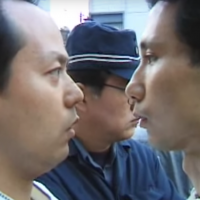Today the saga of Aum Shinrikyo — a doomsday cult that killed 13 Tokyo commuters and poisoned many others with sarin gas in 1995 — seems like something out of a bad manga. What could have possessed so many well-educated middle-class people, to follow Shoko Asahara, a deranged guru who taught a mishmash of Buddhism and nonsense?
Filmmakers have long pondered that and other Aum-related questions. One is Bunyo Kimura, who made "Where Does Love Go?" ("Ai no Yukue," 2012), a drama about an Aum member in hiding and the woman (Asako Maekawa) who supports him. Another is Nobuhiko Hosaka, whose "Lurking — The Silence of the Cult" ("Senpuku," 2013) stars Takako Tsuchiya as an Aum woman on the run after the sarin attack.
Both films are based on the life of former Aum member Naoko Kikuchi, who similarly lived underground until her 2012 arrest, but has since been freed by a Tokyo court, which decided she did not take an active role in Aum's killings. On Dec. 8, both Maekawa and Tsuchiya appeared with writer Karin Amemiya at a talk event at Euro Live in Shibuya.
Having seen "Where Does Love Go?" I can say it makes a sincere attempt to understand what life as an Aum fugitive might have been like. For me, the best film about Aum is still "A," Tatsuya Mori's 1998 documentary about life inside the cult. Granted access to Aum's inner sanctum, Mori captured the humanity and strangeness of the remaining Aum members, as well as the hatred and fear they inspired in society. Today, the film is still a valuable document on not just the pathology of Aum, but also the social upheavals it caused.


















With your current subscription plan you can comment on stories. However, before writing your first comment, please create a display name in the Profile section of your subscriber account page.